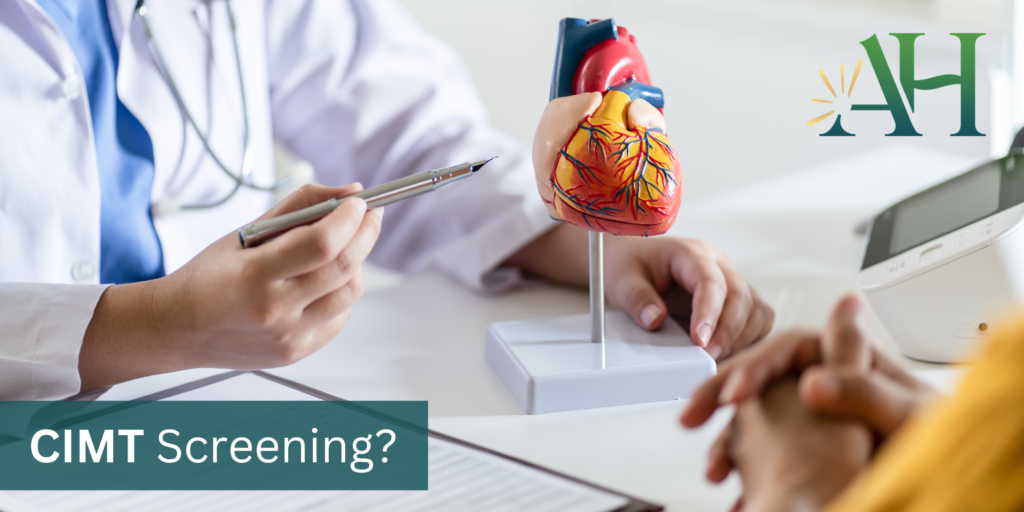Today I want to talk about something that has revolutionized how I think about heart disease. What if I told you that your cholesterol numbers tell you NOTHING about the current health of your heart and surrounding blood vessels? The most common fallacy I see patients and doctors take with heart disease prevention is this idea that if the cholesterol numbers look ok, then you must be at low risk. I hear this or see it in a patient’s chart every. single. day. The reason that heart disease so hard to prevent is that it develops over 20+ years; and your cholesterol numbers says nothing about the road your heart has been on, good or bad. To understand the current state of your heart, to know the “age” of your arteries, you must literally LOOK at your heart.
For the longest time, the only way to look at the state of your arteries was through a heart catheterization, a procedure that required sedation, came with some risk, and cost a lot of money. But now, we have three great ways to not only look at your heart right now but also great options to repeat and track your heart health over time. It is my opinion (and a growing opinion of many heart disease prevention guidelines) that imaging is an indispensable tool and should be strongly considered for anyone looking to prevent a future heart attack or stroke.
We have three imaging options for our cardiovascular system. Two are easy to get and non-negotiable. The third is expensive but great if we can afford it or can get it covered through insurance:

CIMT (Carotid Intimal Media Thickness) Ultrasound
- This is a non-invasive and no-radiation look at the arteries in your neck. Using ultrasound technology, we can measure the thickness of your subendothelial space, the area that heart disease first starts in the artery wall. Studies show that thickness correlates to arterial inflammation and early disease. It can also identify the presence of both soft and hard plaques.
- This test is different than the traditional carotid ultrasound, which is only looking at severe blockages (i.e. >50% blockage) and not artery wall thickness.
- You can repeat this test yearly to monitor your artery health.
- Great test for patients over the age of 30 with 1-2 risk factors for heart disease and not currently on medication.
- Not covered by insurance, costs $185 ($225 if not a patient of Authentic Health). We do these at our office (as of right now, we are the only place offering this test in WNC).
Coronary CT for Calcium (aka Calcium Score)
- CT scan that identifies the presence of hard plaque in the heart arteries
- The score ranges from 0 to >1000, higher scores meaning more calcium is present. (To me, any number >1 means that you have plaque, and we should take it seriously)
- It cannot see soft plaque, so a score of 0 does not mean that your vessels are perfectly clear. However, a score of 0 in someone >65yrs old is very reassuring.
- If you are on a statin, you should not get this test. Statins convert soft plaque to hard plaque, so it’ll always be positive.
- Great test if 45+ years old and can be paired with a CIMT ultrasound. I recommend getting it every 5-10 years.
- Not covered by insurance, costs $100 locally.
Coronary CT Angiogram
- CT scan using dye to see all of the vessels around the heart
- Great at identifying both hard and soft plaque, will also give you a calcium score
- Most complete look at your heart health but also the most invasive test, higher radiation exposure, involves dye that can harm the kidney (rare)
- Some scans incorporate AI technology for more precise measurements (i.e. HeartFlow, Cleerly)
- Great test if you are very high risk, regardless of age
- Very expensive (>$1500 out-of-pocket) but may be billed to insurance

Two Examples:
- Patient 1: 49 years old male, fairly healthy on paper, no family history of heart disease. Over the past 2-3 years, his cholesterol has been slowly creeping up. We decided to get a calcium score. His number? >350 and completely unexpected. This changed his 10 year risk of heart attack from 4.5% (low risk) to 12% (very high risk)! His vascular age? 75 years old! We adjusted our treatment plan to be more aggressive at heart disease prevention and this scan has motivated him to take his lifestyle changes more seriously.
- Patient 2: 49 year old male, had a heart attack 2 years beforehand. He is Lp(a) positive, which I believe was the main culprit behind his early heart attack. He has completely turned his life around: lost weight, exercises regularly, cleaned up his diet, and improved almost all of his lab values. His recent CIMT ultrasound put his vascular age at 31 years old! He did have plaque present (not surprising) but was extremely reassured to see this. We plan to track this yearly to make sure the plaques aren’t growing in size.
I hope these two examples can show you the value in imaging when it comes to better understanding the health of your heart. Next time you’re at the doctor’s office, I encourage you to bring this up and see if cardiac imaging is right for you! Contact us today if you are interested in the heart health evaluations we have available here at Authentic Health.








